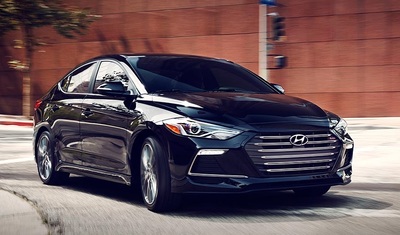HEELS ON WHEELS: 2017 HYUNDAI ELANTRA SPORT REVIEW
HEELS ON WHEELS
By Katrina Ramser
San Francisco Bureau
The Auto Channel
INTRO TO THE ELANTRA SPORT VEHICLE
The Hyundai Elantra offers a mid-size sedan experience with many faces: a fuel-saving Eco trim that retains 35 miles-per-gallon combined; a Limited trim for a more impressive experience; and my recent Sport trim test drive with a fast-acting turbocharged engine and sport-tuned suspension. No matter your preference, the Elantra won’t break your budget and all feature distinct styling and customer-focused technology.
I drove a 2017 Hyundai Elantra Eco with the 201-horsepower 1.6-liter turbo four-cylinder engine with the six-speed manual transmission. The Elantra is available in five trims — the base SE, Value Edition, Eco, Sport and Limited — with standard equipment on my Sport trim including: leather upholstery; heated front seats; alloy sport pedals; Android Auto and Apple CarPlay; Bluetooth connectivity sliding center armrest; a seven-speaker audio system; sport instrument gauge cluster with a black headliner; hands-free smart trunk; iPod and USB input jacks; push-button start; a six-speed manual transmission; and 18-inch alloy wheels. Price as described for the Elantra Sport without options is $21,650.
Fully redesigned for the model year, the Elantra adds a new exterior look, a revised cabin with better technology, and retuned engines. A competitor that can offer similar savvy style and smart fuel economy includes the Ford Fusion, Honda Accord, and Toyota Camry. I have also recently test driven the Elantra Eco with the 128-horsepower 1.4-liter turbo four-cylinder engine well as the Limited with the 147-horsepower 2-liter four-cylinder engine.
HEELS ON WHEELS REVIEW CRITERIA
Stylish But Comfortable Results: The Elantra’s design commands a second glance for a sporty looking sedan that appears more expensive than it actually is. Standouts on the Sport trim are the flat-bottom leather steering wheel, red contrast stitching on the upholstery, and sportier exterior fascia. Having driven a few Elantra vehicles, I’d go with the Limited, Sport, or Value Edition trim (the latter adds such notables as a power driver’s seat, heated front seats, a sliding armrest, push-button start, Bluetooth, and safety tech like a rearview camera and Blind Spot Detection). The Sport trim does allow for the $2,400 optional Premium Package that adds an eight-inch display with navigation, an Infinity premium audio system, Clar-fi music restoration technology, BlueLink Connected Car Care, a sunroof, and Blind Spot Detection with Rear-cross Traffic Alert. These features are an extra cost on the Limited as well, so paying more is unavoidable. What’s refreshing in this technology age is the climate controls remain as easy-to-access dials when many makers have switched to button commands, or worse – temperature controls only accessible through a digital screen.
Reliability & Safety Factor: The Insurance Institute for Highway Safety (IIHS) gives the 2017 Hyundai Elantra sedan model a Top Safety Pick rating with ratings pf “Good” in all areas omitting ease of use with LATCH (inserting child seats). I’d also like to comment my five-year old experienced frustration with clicking in her own belt. The National Highway Traffic Safety Administration (NHTSA) gives the hatchback sedan version an overall rating of 4-Stars (yet the hatchback gets 5-Stars). Standard safety equipment includes electronic stability control, vehicle stability management, traction control, anti-lock brakes, brake assist, and an advanced airbag system. A review camera and Blind Spot Detection are standards starting with the Value Edition, but any additional safety technology options like Lane Keep Assist and Forward Collision Warning are paid extras on the Limited only.
Cost Issues: The Hyundai Elantra is a great deal with the Eco trim at $20,650; a fully loaded Limited with options a tame $27,710; and the Sport trim with options at $24,175. A recent Mazda6 sedan with all the fixings (Grand Touring trim) ran $33,695.
IActivity & Performance Ability: Having driven both the Eco and Limited trims with smaller engines, I can attest the 1.6-liter delivers a stronger punch and left me with an even much more satisfying experience and get closer to what the Fusion and Mazda’s SKACTIV-G technology can do. Hyundai has revised the power steering for a better road feel, and it does overall ride like a larger vehicle.
The Green Concern: Fuel economy with the 1.4-liter Eco version is 32-city and 40-highway for a combined 35. The 2-liter four-cylinder engine retains 28 miles-per-gallon city and 37 highway for a combined 32. The Sport with the 1.6-liter does drop a tad to 22-city and 30-highway for a combined 25 miles-per-gallon. The Mazda6’s 184-horsepower 2.5-liter four-cylinder can get 29 miles-per-gallon.
FINAL PARTING WORDS
In my previous reviews for the 2017 Hyundai Elantra with the Eco and Limited, I cited the less powerful engines as shedding a few appeal points – but with the Sport trim, you get the affordable and attractive sedan choice featuring the gusto you crave.
©2017 Katrina Ramser Parrish
The Most In-Depth Independent Hyundai Buyer's Research - Anywhere!
- Ready To Buy? Save Hundreds As An Unencumbered Free-to-the-Dealer Independent Buyer
- Hyundai Buyers Guide | Specs, Prices, Expert Reviews and Comparisons 2018-1997
- Find Your Perfect New Car Match
- Hyundai Reviews From The Auto Channel (1993-Present)
- The Auto Channel's Hyundai Brand Archives; News, Press Releases, Reviews, Specifications, Prices, Video, Images (54,234 Annotations)



